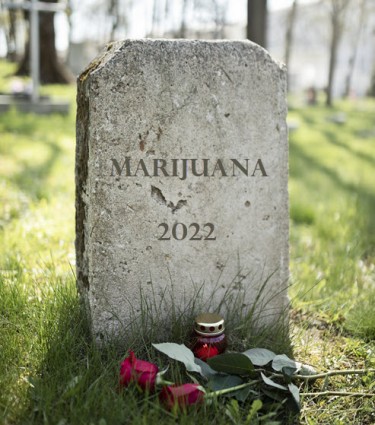
The Strange Case of Delta-8 THC
Should States Ban Synthetic Cannabis?
As of July 1, 2022, Oregon became the first state to ever ban synthetic cannabinoids from retailers and grocery stores.
According to regulators, the sale of synthetic cannabinoids has been banned due to growing concerns about the dangerous chemicals used in these harmful products. To create these products, manufacturers isolate them or make them synthetically in a laboratory. Despite not containing THC, most synthetic cannabinoid products are completely unregulated.
Synthetically produced cannabinoids have made headlines due to the numerous dangerous, if not near fatal, intoxications they cause. Delta-8-THC in particular has been on the Centers for Disease Control’s radar due to over 100 hospital admissions in half a year. But delta-8-THC, as well as other synthetically produced cannabinoids like CBN and CBD, occur naturally in the cannabis plant, albeit in such small amounts that a laboratory process is required to produce more.
According to Christopher Hudalla, Chief Scientific Officer of ProVerde Labs, there are many serious health and safety risks associated with the manufacture of synthetic cannabinoids. “You can easily do this in your garage,” he told Analytical Cannabis last year. “CBD is almost free. There is so much CBD glut that it is very, very cheap. It used to be about 12 cents per milligram. Now I can buy it for probably 0.1 cents per milligram,” he said. “And you can take that and convert it to Delta-8 in your garage. So the margins are very good.”
“There is no regulatory control,” adds Hudalla. “And so we know that children are consuming these products without any indication of how safe they are. In my opinion, that is very irresponsible.”
how did we get here
Sometime in the mid-2000s, synthetic cannabis products began showing up in gas station and convenience stores. Also known as Spice and K2, they were made from substances not specifically prohibited by federal or state law. By the time we got to the end of the decade, however, many states had already banned their sale.
In 2012, President Obama enacted the Synthetic Drug Abuse Prevention Act. This has helped severely restrict numerous synthetic cannabinoids under the Schedule 1 classification—unfortunately the same classification real marijuana has at the moment.
Oregon is the first-ever state to ban the sale of lab-grown marijuana, but at least 43 other states have already restricted synthetic cannabinoids in some way. However, I believe all states should follow Oregon as this highly unregulated product poses a serious risk to society. Although the FDA doesn’t regulate the medical marijuana industry, a strict (and expensive!) licensing process is required for individuals or businesses to set up dispensaries. Additionally, there’s a big difference from synthetic cannabinoids and the legal marijuana industry, as states set their own regulations on cannabis and educated consumers know to look for established brands. A Certificate of Analysis is also provided by some brands for consumers who want reassurance as to what is really in each product they put on their bodies.
Marijuana is primarily grown for its therapeutic uses, much like its CBD-rich cousin – hemp – which is also grown for other uses, such as use in textiles and even concrete substitutes. On the other hand, synthetic cannabinoids appear to be just trying to mimic the effects of marijuana. That’s why it’s so appealing to those who don’t know any better – like teenagers, who also don’t have the budget to shop at pharmacies. This is why there is such a high risk of synthetic cannabinoid manufacturers entering the market.
There needs to be at least some sort of regulatory framework so we can prevent its damage. Spice and K2 used to be sold as marijuana, although all you can do is sniff or touch the stuff and you’ll know it’s not the real thing. But these days, synthetic cannabis is already being infused into chewing gum, after that there’s no way to tell the difference.
Delta-8 THC products are also thriving in the market these days, but care must be taken no matter how experienced a cannabis user you consider yourself to be. According to the FDA, there were 104 cases of side effects in people who consumed delta-8-THC from December 2020 to February 2022. 55 percent of them required medical intervention, such as hospitalization or ambulance, while 66 percent reported side effects after consuming delta-8-THC edibles. Side effects included vomiting, anxiety, tremors, loss of consciousness and hallucinations to name a few.
It also casts reality in a bad light.
In 2019, the American Association of Poison Control Centers stated that CBD was considered an “emerging hazard” due to cases of contamination and mislabeling, according to a CNBC report.
Ultimately, it is up to states to use the necessary law enforcement methods and administrative measures to completely ban these substances and their sale. While regulating them might help in some ways, all the bad news about the dangers just outweighs the benefits, and simply put, if the real marijuana is out there, why do people have to succumb to the fake stuff in the first place?
Sure, it’s a lot cheaper to produce synthetic cannabis – but is your health worth the risk? Fall into a coma, get hospitalized and feel like you’re going to die? These are things cannabis will never do to you.
So it’s up to the states to ban them. And it’s high time all states followed in Oregon’s footsteps.
THE DELTA 8 DEBATE, READ MORE…

THE MARIJUANA INDUSTRY IS DEAD – THE CASE OF HEMP DELTA-8

Post a comment: